#894 Lasers in Eta Carinae November 29, 1997
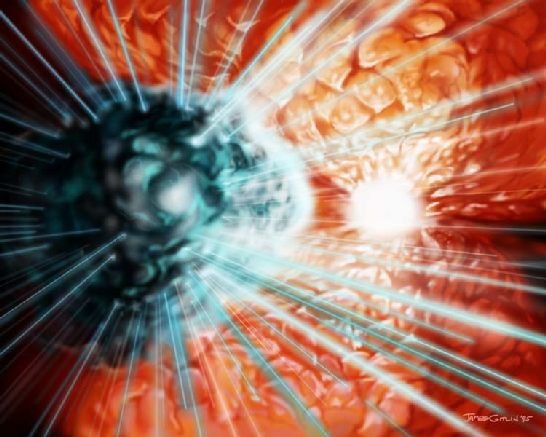
“Have you heard about the great LASER light show in the sky? A team led by K. Davidson (U. Michigan) and S. Johansson (U. Lund) discovered that the chaotically variable star Eta Carinae emits ultraviolet light in such a narrow band that it is most probably LASER light! This artist's vision depicts a model that could account for their Hubble Space Telescope observations. In this model, Eta Carinae emits many LASER beams from its surrounding cloud of energized gas. Infrared LASERS and microwave MASERS are extremely rare astrophysical phenomena, but this natural ultraviolet LASER is the first of its kind to be discovered."
Copyright: Public domain
#895 Mercury: A Cratered Inferno November 30, 1997
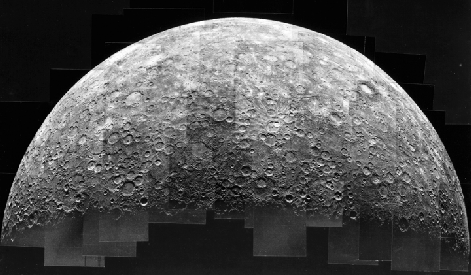
“Mercury's surface looks similar to our Moon's. Each is heavily cratered and made of rock. Mercury's diameter is about 4800 km, while the Moon's is slightly less at about 3500 km (compared with about 12,700 km for the Earth). But Mercury is unique in many ways. Mercury is the closest planet to the Sun, orbiting at about 1/3 the radius of the Earth's orbit. As Mercury slowly rotates, its surface temperature varies from an unbearably cold -180 degrees Celsius to an unbearably hot 400 degrees Celsius. The place nearest the Sun in Mercury's orbit changes slightly each orbit - a fact used by Albert Einstein to help verify the correctness of his then newly discovered theory of gravity: General Relativity. The above picture was taken by the only spacecraft ever to pass Mercury: Mariner 10 in 1974."
Copyright: Public domain
#896 Orion: The Big Picture December 01, 1997
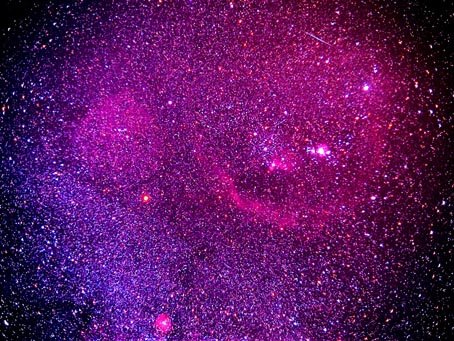
“Orion is big. Some of the stars that form the constellation of Orion are part of a giant gas cloud complex that stretches over 100 light years and appears more than 50 times the diameter of the Moon. Components of this cloud include the Horsehead Nebula, the Orion Nebula, the Trapezium open cluster, and small disks containing stellar systems which are just forming. At 1500 light years, Orion is the closest star forming region to Earth. Close inspection of the photo's center should reveal the three stars which form the belt of Orion."
Copyright: J. C. Casado
#897 Micro-Quasar GRS1915 Puffs December 02, 1997
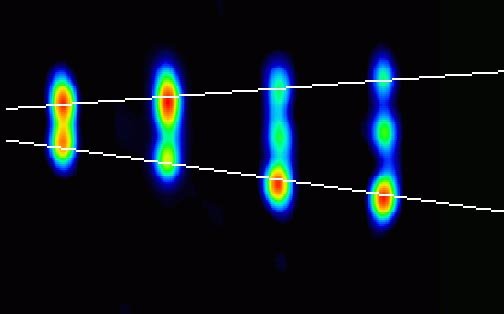
“On the far side of our Galaxy, gas clouds explode away from a small black hole. This might seem peculiar, as black holes are supposed to attract matter. But material falling toward a black hole collides and heats up, creating an environment similar to a quasar that is far from stable. In the above time-lapse sequence, micro-quasar GRS1915 expels bubbles of hot gas in spectacular jets. These computer enhanced radio images show one plasma bubble coming almost directly toward us at 90 percent the speed of light, and another moving away. Each of the four frames marks the passage of one day. Originally detected on October 29th, these bubbles have now faded from view."
Copyright: Public domain
#898 Runaway Star December 03, 1997
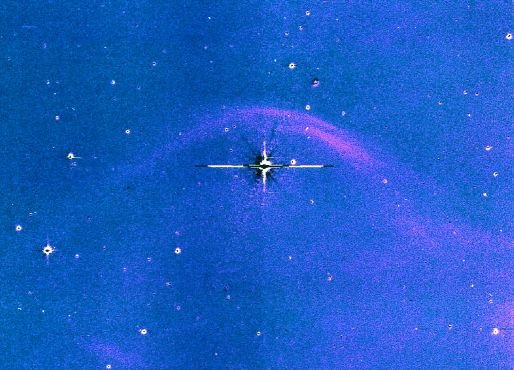
“Runaway stars are massive stars traveling rapidly through interstellar space. Like a ship plowing through the interstellar medium, runaway star HD 77581 has produced this graceful arcing bow wave or "bow shock" - compressing the gaseous material in its path. Located near the centre of this European Southern Observatory photograph, HD 77581 itself is so bright that it saturates the sensitive camera and produces the spiky cross shape. This star is over 6,000 light-years away in the constellation Vela, and appears to move at over 50 miles per second. What force could set this star in motion? A clue to the answer may lie in its optically invisible companion star, an X-ray bright pulsar known as Vela X-1. This pulsar is clearly the remnant of a supernova explosion ... which seems to have given this massive star and its companion a mighty kick!"
Copyright: Public domain
#899 A Sky Full Of Planets December 04, 1997
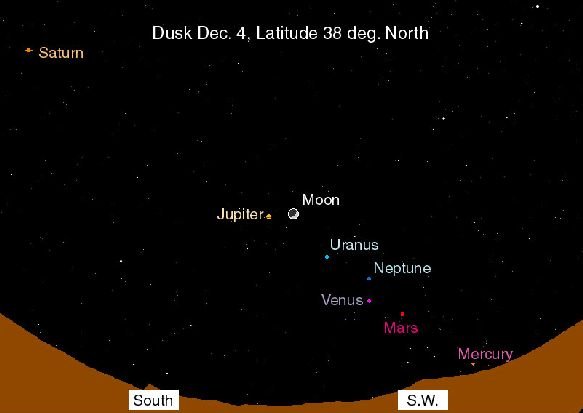
“Look up tonight. Just after sunset, the crescent moon and all five "naked-eye" planets (Mercury, Venus, Mars, Jupiter, and Saturn) will be visible (depending on your latitude), lying near our solar system's ecliptic plane. Venus and Jupiter will shine brilliantly as the brightest "stars" in the sky, but Mercury will be near the horizon and hard to see. A pair of binoculars will also reveal Uranus and Neptune and observers with a telescope and a good site may even be able to glimpse faint Pluto just above the Western horizon in the fading twilight (not shown on the chart above). Enjoy this lovely spectacle any clear night through about December 8. A similar gathering is expected in May 2000 but the planets will be hidden from view by the solar glare. A night sky as full of planets as this one will occur again though ... in about 100 years."
Copyright: Public domain
#900 Seeing Through Galaxies December 05, 1997
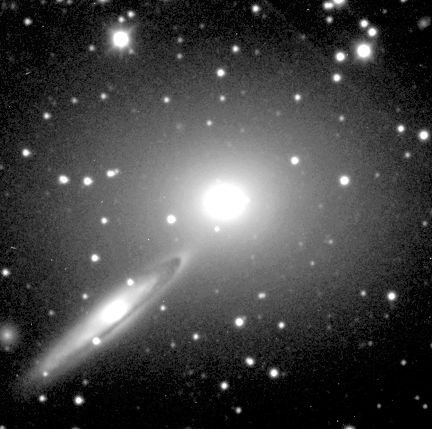
“In this dramatic picture, spiral galaxy NGC 5091 appears in the foreground. Tilted nearly edge-on, the dust lanes between its spiral arms are clearly visible. The large elliptical galaxy NGC 5090 lies just beyond it - both are about 100 million light years distant in the southern constellation Centaurus. Can you see through the spiral galaxy? The detailed answer to this question has important implications for determining the nature of dark matter and the measurement of star formation rates. Comparing the overlapping and non-overlapping parts of this and other pairs of galaxies offers a neat way to find the answer."
Copyright: Public domain
#901 A Quasar Portrait Gallery December 06, 1997
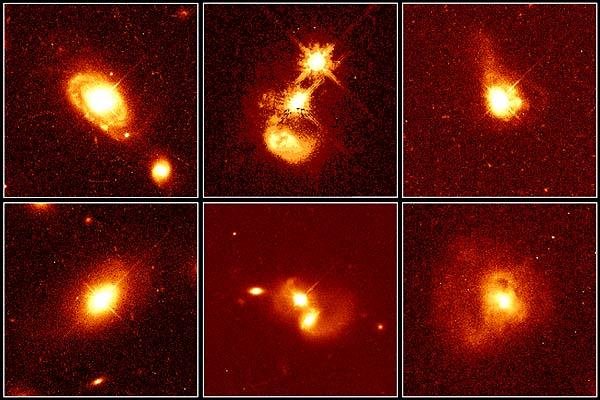
“QUASARs (QUASi-stellAR objects) lie near the edge of the observable Universe. Discovered in 1963, astronomers were astounded that such objects could be visible across billions of light-years, as this implies they must emit prodigious amounts of energy. Where does the energy come from? Many believe the quasar's central engine is a giant black hole fueled by tremendous amounts of infalling gas, dust, and stars. This gallery of quasar portraits from the Hubble Space Telescope offers a look at their local neighborhoods: the quasars themselves appear as the bright star-like objects with diffraction spikes. The images in the center and right hand columns reveal quasars associated with disrupted colliding and merging galaxies which should provide plenty of debris to feed a hungry black hole."
Copyright: Public domain
#902 A Distant Cluster of Galaxies December 07, 1997
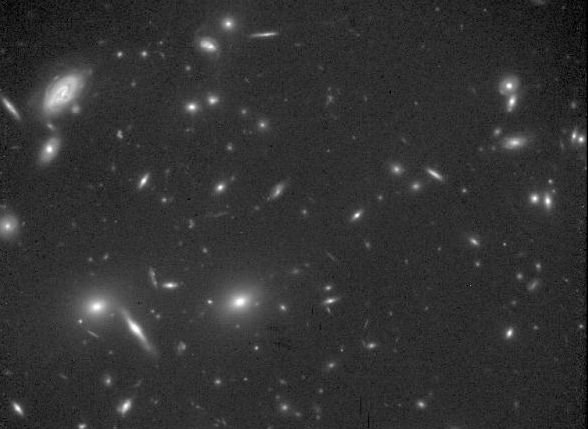
“In this 1994 Hubble Space Telescope photograph, every bright object is a galaxy. Oddly - most of them are spiral galaxies. This rich cluster of galaxies, named CL 0939+4713, is almost half way across the visible universe. Photos like this indicate that clusters in the past contained a higher fraction of spirals than do nearby clusters which are usually dominated by elliptical galaxies."
Copyright: Public domain
#903 The Trifid Nebula in Red, White and Blue December 08, 1997
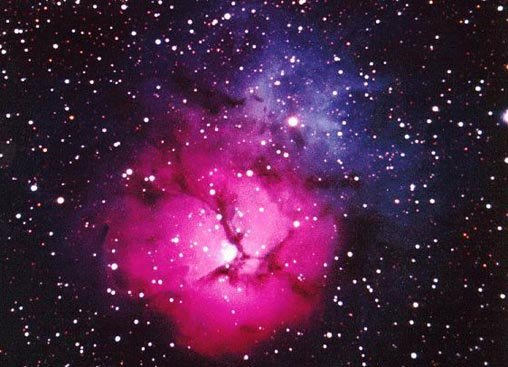
“Three dark dust lanes give the picturesque Trifid Nebula its name. The red and blue colors of the Trifid Nebula are present in different regions and are created by different processes. A big bright star near the center of the red region appears white hot and emits light so energetic it knocks electrons away from gas surrounding it. When an electron is recaptured by a proton, red light is frequently emitted. The blue region is centered on another bright star but this region's dust reflects light to us. The two regions are thus called an emission nebula and reflection nebula, respectively. The Trifid Nebula can be seen in Sagittarius toward the Galactic Center with a small telescope."
Copyright: Jason Ware
Upvote! Resteem! Comment! As you like it! Thank you for attention!